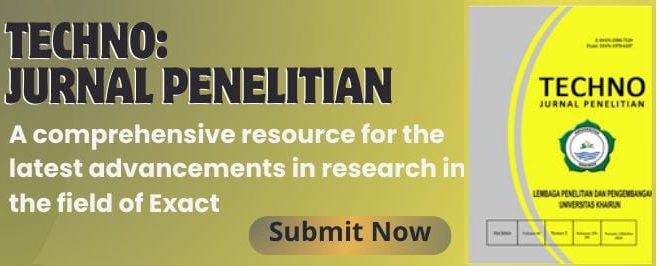Activated Carbon from Mulu Bebe Stem Waste for Methylene Blue (MB) Adsorption
Abstract
Methylene blue is a harmful synthetic dye waste component that poses a significant threat to the environment and human health if not disposed of properly. The best way to tackle this problem is by adsorption through activated carbon from Mulu Bebe banana stems, which are widely available in North Maluku. This agricultural waste can be used to produce activated carbon through pyrolysis at 500ËšC for 30 minutes and activation using 0.5 M KOH solution for 24 hours. The activated carbon is then characterized using FTIR, SEM and XRD, which reveal the presence of various functional groups and pores. The XRD results indicate that the activated carbon structure tends to be amorphous. The adsorption analysis shows that the activated carbon from Mulu Bebe banana stems has a high adsorption capacity of 12.4 mg/g at the optimum condition of pH 7, contact time of 30 minutes, and initial concentration of 50 ppm. The Langmuir and Freundlich equations provide the best fit for the equilibrium adsorption data. By using activated carbon from Mulu Bebe banana stems, we can effectively reduce the amount of methylene blue waste in the environment and protect the ecosystem and human health.
Keywords
Full Text:
PDFReferences
Al-Ghouti, M. A., Da’ana, D., Abu-Dieyeh, M., & Khraisheh, M. (2019). Adsorptive Removal of Mercury from Water by Adsorbents Derived from Date Pits. Scientific Reports, 9(1), 1-15. https://doi.org/10.1038/s41598-019-51594-y
Catanho, M., Malpass, G. R. P., & Motheo, A. D. J. (2006). Evaluation of Electrochemical and Photoelectrochemical Methods for The Degradation of Three Textile Dyes. Quimica Nova, 29(5), 983–989. https://doi.org/10.1590/s0100-40422006000500018
Chong, M. Y., & Tam, Y. J. (2020). Bioremediation of Dyes Using Coconut Parts Via Adsorption: A Review. SN Applied Sciences, 2(2), 1–16. https://doi.org/10.1007/S42452-020-1978-y/figures/6
Choo, H. S., Lau, L. C., Mohamed, A. R., & Lee, K. T. (2013). Hydrogen Sulfide Adsorption by Alkaline Impregnated Coconut Shell Activated Carbon. Journal of Engineering Science and Technology, 8(6), 741–753.
Foo, K. Y., & Hameed, B. H. (2012). An Overview of Dye Removal via Activated Carbon Adsorption Process. New Pub: Balaban, 19(1–3), 255–274. https://doi.org/10.5004/dwt.2010.1214
Guerra, D. L., Batista, A. C., Viana, R. R., & Airoldi, C. (2010). Adsorption of Methylene Blue on Raw and MTZ/Imogolite Hybrid Surfaces: Effect of Concentration and Calorimetric Investigation. Journal of Hazardous Materials, 183(1–3), 81–86. https://doi.org/10.1016/j.jhazmat.2010.06.109
Han, M. H., & Yun, Y. S. (2007). Mechanistic Understanding and Performance Enhancement of Biosorption of Reactive Dyestuffs by The Waste Biomass Generated from Amino Acid Fermentation Process. Biochemical Engineering Journal, 36(1), 2–7. https://doi.org/10.1016/j.bej.2006.06.010
Huang, Y., Li, S., Chen, J., Zhang, X., & Chen, Y. (2014). Adsorption of Pb(II) on Mesoporous Activated Carbons Fabricated from Water Hyacinth using H3PO4 Activation: Adsorption Capacity, Kinetic and Isotherm Studies. Applied Surface Science, 293, 160–168. https://doi.org/10.1016/j.apsusc.2013.12.123
Jia, P., Tan, H., Liu, K., & Gao, W. (2018). Removal of Methylene Blue from Aqueous Solution by Bone Char. Applied Sciences, 8(10), 1-11. https://doi.org/10.3390/app8101903
Kaomierczak, J., Nowicki, P., & Pietrzak, R. (2013). Sorption Properties of Activated Carbons Obtained from Corn Cobs by Chemical and Physical Activation. Adsorption, 19(2–4), 273–281. https://doi.org/10.1007/s10450-012-9450-y
Khan, I., Saeed, K., Ali, N., Khan, I., Zhang, B., & Sadiq, M. (2020). Heterogeneous Photodegradation of Industrial Dyes: an Insight to Different Mechanisms and Rate Affecting Parameters. Journal of Environmental Chemical Engineering, 8(5), 1-14. https://doi.org/10.1016/j.jece.2020.104364
Manjuladevi, M., Anitha, R., & Manonmani, S. (2018). Kinetic Study on Adsorption of Cr(VI), Ni(II), Cd(II) and Pb(II) Ions from Aqueous Solutions using Activated Carbon Prepared from Cucumis Melo Peel. Applied Water Science, 8(1), 1-8. https://doi.org/10.1007/s13201-018-0674-1
Mondal, M. K., & Garg, R. (2017). A Comprehensive Review on Removal of Arsenic using Activated Carbon Prepared from Easily Available Waste Materials. Environmental Science and Pollution Research, 24(15), 13295–13306. https://doi.org/10.1007/s11356-017-8842-7
Mulana, F., Muslim, A., & Nurul Alam, P. (2015). Adsorption of Pb (II) Heavy Metals from Wastewater Using Modified Rice Husk as Adsorbent. Proceedings of The 5th Annual International Conference Syiah Kuala University (AIC Unsyiah) 2015, I, 12–17.
Sahoo, T. R., & Prelot, B. (2020). Adsorption Processes for The Removal of Contaminants from Wastewater. In Nanomaterials for the Detection and Removal of Wastewater Pollutants (pp. 161–222). Elsevier Inc. https://doi.org/10.1016/b978-0-12-818489-9.00007-4
Yu, J. G., Yue, B. Y., Wu, X. W., Liu, Q., Jiao, F. P., Jiang, X. Y., & Chen, X. Q. (2016). Removal of Mercury by Adsorption: A Review. Environmental Science and Pollution Research, 23(6), 5056–5076. https://doi.org/10.1007/s11356-015-5880-x
Yuan, N., Cai, H., Liu, T., Huang, Q., & Zhang, X. (2019). Adsorptive Removal of Methylene Blue from Aqueous Solution using Coal Fly Ash-Derived Mesoporous Silica Material. Adsorption Science and Technology, 37(3–4), 333–348. https://doi.org/10.1177/0263617419827438
Zhang, F. S., Nriagu, J. O., & Itoh, H. (2005). Mercury Removal from Water using Activated Carbons Derived from Organic Sewage Sludge. Water Research, 39(2–3), 389–395. https://doi.org/10.1016/j.watres.2004.09.027
Zhao, M., & Liu, P. (2008). Adsorption Behavior of Methylene Blue on Halloysite Nanotubes. Microporous and Mesoporous Materials, 112(1–3), 419–424. https://doi.org/10.1016/j.micromeso.2007.10.018
DOI: https://doi.org/10.33387/tjp.v13i1.6862
Refbacks
- There are currently no refbacks.
Copyright (c) 2024 Indra Cipta, Nur Jannah Baturante, Zulkifli Zam Zam, Yunita Pare Rombe

This work is licensed under a Creative Commons Attribution-NonCommercial 4.0 International License.
-------------------------------------------------------------------------------------------------------------------------------------------------------------------
-------------------------------------------------------------------------------------------------------------------------------------------------------------------
TECHNO: Jurnal Penelitian
Published by: LPPM Universitas Khairun
Addres : Jalan Yusuf Abdurrahman Kampus II Unkhair, Kelurahan Gambesi, 97722 Kecamatan Kota Ternate Selatan, Provinsi Maluku Utara, Email: techno@unkhair.ac.id | URL: http://ejournal.unkhair.ac.id/index.php/Techno
Techno Jurnal Penelitian is licensed under a Creative Commons Attribution-NonCommercial 4.0 International License.


























